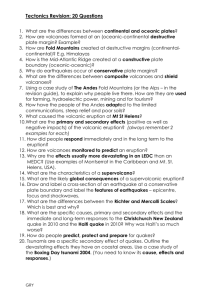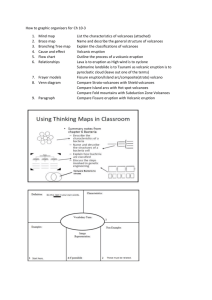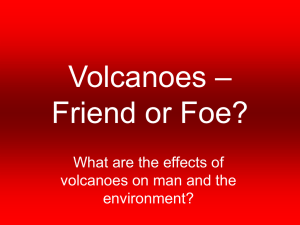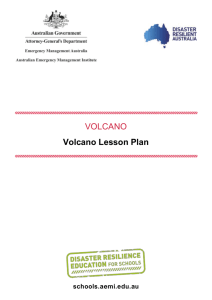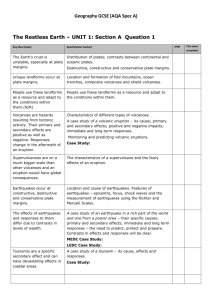Volcanoes Research Simulation Task (RST)
advertisement
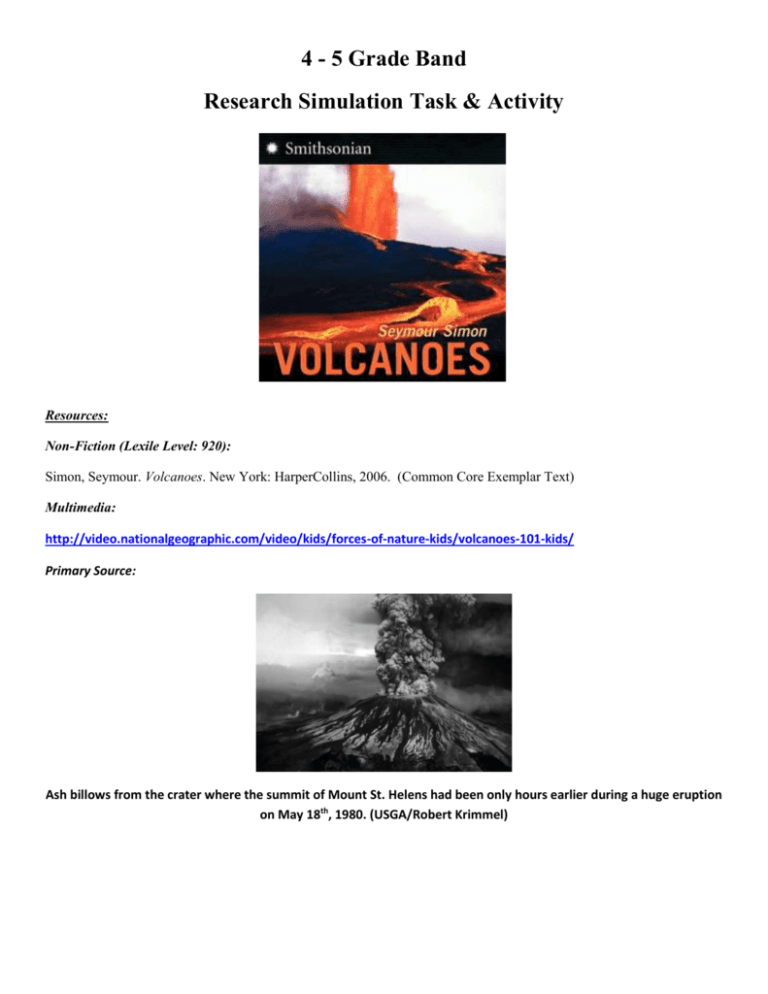
4 - 5 Grade Band Research Simulation Task & Activity Resources: Non-Fiction (Lexile Level: 920): Simon, Seymour. Volcanoes. New York: HarperCollins, 2006. (Common Core Exemplar Text) Multimedia: http://video.nationalgeographic.com/video/kids/forces-of-nature-kids/volcanoes-101-kids/ Primary Source: Ash billows from the crater where the summit of Mount St. Helens had been only hours earlier during a huge eruption on May 18th, 1980. (USGA/Robert Krimmel) Lesson Overview Part I: Volcanoes As the teacher is reading the text, students and teacher will read for ways volcanoes are land creators and ways volcanoes are land destroyers. Students will take notes on their graphic organizer. See sample belowWays Volcanoes Are Land Creators Ways Volcanoes Are Land Destroyers Part II: Video Analysis Volcanoes 101 National Geographic for Kids (running time 3:04) http://video.nationalgeographic.com/video/kids/forces-of-nature-kids/volcanoes-101-kids/ Students will complete the Main Idea Video Analysis Graphic Organizer (see below) as they watch the video. Essential Question for video analysis: How do volcanoes change Earth when they erupt? Main Idea Video Analysis The Question I Am Answering Is…. How do volcanoes change Earth when they erupt? Thinking Notes… 1. 2. 3. 4. The Video is Mostly About… Part III: Primary Document/Small Group Activity Ash billows from the crater where the summit of Mount St. Helens had been only hours earlier during a huge eruption on May 18th, 1980. (USGA/Robert Krimmel) See OPTIC Handout below Small Group Activity: Students should work in small groups to analyze the primary source document and complete the OPTIC handout. OPTIC: Mount St. Helens Ash billows from the crater where the summit of Mount St. Helens had been only hours earlier during a huge eruption on May 18th, 1980. (USGA/Robert Krimmel) Overview Parts 1. 2. 3. 4. Title Interdependence Conclusion Information on OPTIC Strategy: Analyzing Visual Texts Using OPTIC Paying attention to the details is a habit that is a necessary part of effective analysis. As you analyze visual texts, including paintings, photographs, advertisements, maps, charts or graphs, the OPTIC strategy can help you construct meaning. OPTIC stands for Overview, Parts, Title/Text, Interrelationship, and Conclusion. As you examine a visual text, respond to each element: O- Write a brief overview of the image: in one complete sentence, what is this image about? P- Key in on all of the parts by noting any details that seem important. This can be anything: color, figures, textures, scenery, groupings, shadings, patterns, numbers, etc. T- Use the title to clarify the subject of the image. Consider both literal and metaphoric meanings. What does the title suggest? Is there any text in the image—a caption, or words in the image itself? What might this text suggest? I- Specify the interrelationships in the image. In other words, how the parts are related, both to one another and the image as a whole. Consider how the parts come together to create a mood or convey an idea or argument. C- Write a conclusion paragraph about the image as a whole: think about what the artist, photographer, creator, or designer might be trying to capture and convey, and what ideas, arguments, or implications this image presents. Citation: https://pixleysap.pbworks.com/w/page/25778707/OPTIC%20Strategy Culminating Task: Using information from all three sources- text, video, and picture- students will write a newspaper article about a recent volcanic eruption in the form of a RAFT. Role: Scientist Audience: Newspaper/magazine readers Format: Newspaper/magazine article Topic: The effect of a volcanic eruption on the Earth Student directions: take the role of a scientist writing a newspaper/magazine article about a recent volcanic eruption. Explain to your readers why the volcanic eruption was either harmful or helpful to the Earth. You must either take the position that volcanoes are harmful to the Earth or helpful to the Earth. Your scientific opinion must be supported with facts from the sources. 4th – 5th RST Rubric: Score Point 4 All “3” PLUS: (EXCEEDS) Cites more than two items of textual evidence to support analysis Score Point 3 Makes connections (either explicit and/or inferential) between ideas expressed in text(s) to other text(s) using textual evidence as support Response provides an accurate analysis of what the text says explicitly (specifically stated) (MEETS) Response provides an accurate analysis of what the text says inferentially (or implies) Score Point 2 Cites two items of textual evidence to support analysis Shows accurate comprehension of ideas expressed in text(s) Includes 3 of the “Meets” criteria (PROGRESSING) Score Point 1 (task may be repeated after re-teaching) (BEGINNING) Score Point 0 (DOES NOT MEET) Includes 2 of the “Meets” criteria (task may be repeated after re-teaching) Includes fewer than 2 of the “Meets” criteria (task may be repeated after re-teaching) “OPTIC” ANALYSIS OF VISUAL INFORMATION – GRAPHIC ORGANIZER Overview Parts 1. 2. 3. 4. Title Interdependence Conclusion
